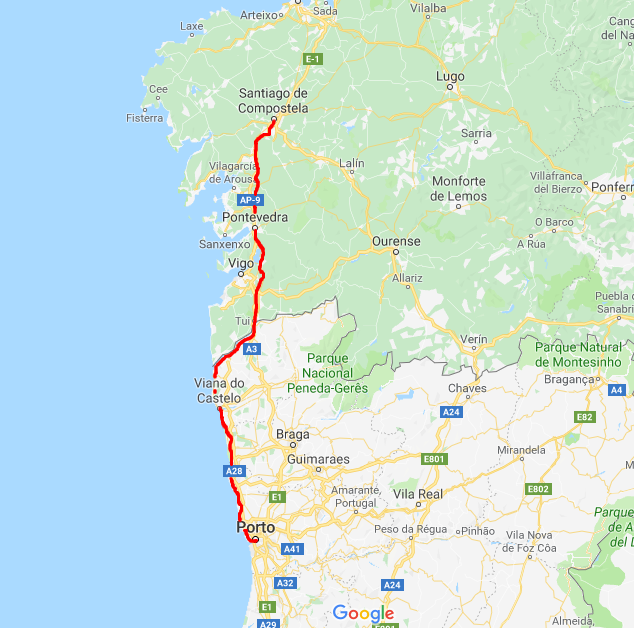Camino
Portuguese 2019
Patron - St. James the Greater, Our
Lady of Fatima
From May 1 to May 11, I walked 175 miles from Porto,
Portugal to Santiago de Compostela, Spain to visit the relics of St. James
the Greater. For over 400,000 steps, through mud, rain, blisters, and
incredible scenery, I carried your intentions written on a sealed piece of
paper to lay at the tomb of St. James. I not only want to share some
photographs from my pilgrimage, but also to tell you my motivation for
making the journey.
Before I do that, let me thank you from the bottom of
my heart for your prayers and well wishes, for you truly helped me to
persevere. I had no illness, no injuries, no serious delays. There was
penance aplenty through soreness and such, but nothing serious. Thank you!
This trip almost didn't happen, for I was diagnosed
with a shallow melanoma ("in situ") on Ash Wednesday. It was a small spot
on my back, but due to the seriousness and rate of growth of this
particular cancer, I needed to undergo surgery immediately to have a
larger area removed to check if it was clear of cancer. The concern was
whether I could get the procedure completed in time (including stitch
removal) in addition to what would have to happen should the biopsy show
more cancer. Thankfully, the VA found me a time slot for surgery and the
biopsy came back clear a week before I was set to go.
I not only walked in gratitude for a clean bill of
health and the ability to make the trip, but also for the blessing that
the melanoma has been in my life. Months before the diagnosis, I wrote a
reflection on what I wanted from the pilgrimage. Being on the downhill
side of 40, I wanted the pilgrimage to put me in a spiritual position to
live out the remaining part of my life in great fidelity to God, with my
life ever more focused on love of Him and love of neighbor. The diagnosis
was a blessing because, in a snap, it radically sorted out what is
important and what is not. It helped to reconnect me with the simple fact
that I am mortal, and time is short.
Through many hidden graces and private blessings
during the walk, God confirmed that I'm where He desires me to be, and
this is a great gift for which I am eternally thankful. May God bless you
and yours, and may we all live in fidelity to that Love that called us
into this mysterious pilgrimage of life that we walk together.
-Matthew
The
Route
(click
photos to enlarge)
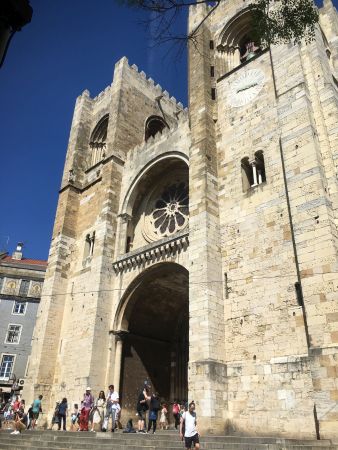
Lisbon Cathedral. I flew into Madrid, then caught a flight to
Lisbon, a traditional site for beginning the Camino
Portuguese.
|
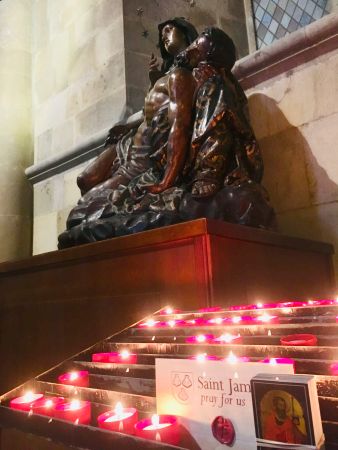
Inside the Lisbon Cathedral, I entrusted the pilgrimage and
your intentions to Jesus through Mary, asking for the graces
needed to make it to Santiago.
|

Lisbon is very hilly and
breathtaking.
|
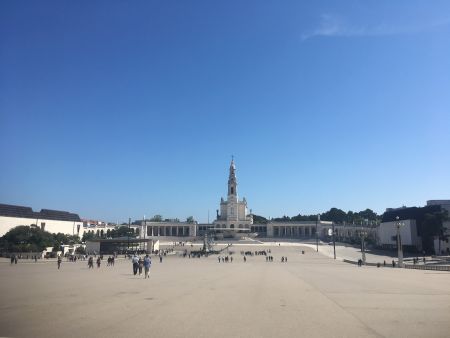
The day after arriving in Lisbon, I took a bus to Fatima, a
famous Marian apparition site. I found it fascinating how it
had a completely different atmosphere from the apparition site
of Lourdes, France. Lourdes is maternal, beautiful in a
tradition sense, and almost womb-like, for Mary appeared in a
cave swaddled in the lush mountains of the Pyrenees. It befits
her message of healing and her being the Immaculate
Conception.
|
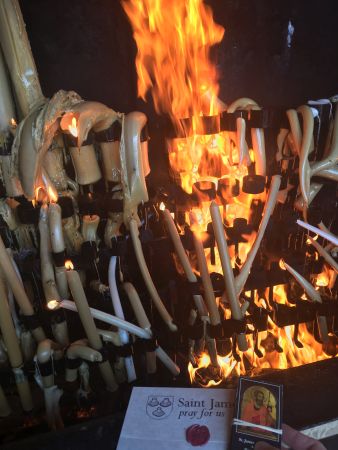
Fatima, however, is beautiful in an apocalyptic sense. Fatima
is Our Lady as the powerful woman of Revelation with the moon
under her feet and twelve stars above her head, crushing Satan
underfoot. The land is dry and more flat, the church and
surroundings more empty and austere. Even the candle areas
reflect this - Lourdes has softly burning candles upright in
their holders, while candles at Fatima quickly lean and fall
from the intense heat, fueling large flaming areas of melted
wax, black smoke climbing from the chimneys.
Again, this befits the message given at Fatima - penance for
sinners, the reality of Hell, the warnings of World War 2 and
the horrors to come if Russia did not repent.
|
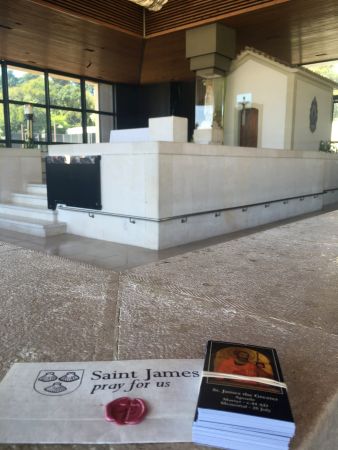
Apparition site at Fatima
|
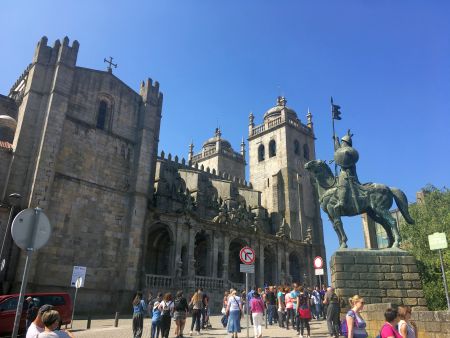
One more bus from Fatima
to Porto, Portugal, and I have to start traveling by foot. I
decided to begin my walk from the Porto Cathedral.
|

Porto Cathedral
|
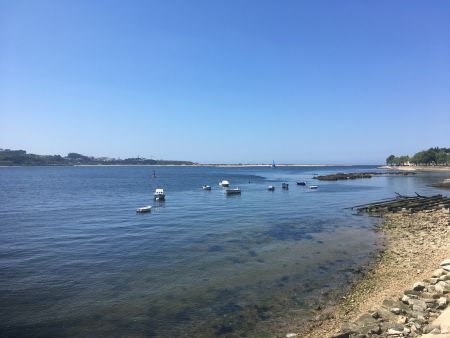
From the Cathedral, I
followed the Duoro River west, heading towards the Atlantic
Ocean. The mouth of the Duoro (and the Atlantic) are off in
the distance.
|

The day was sunny, warm, and very windy. The sea was crashing
against some rocks and a jetty, but I wanted a photo with the
intentions since the Atlantic would be our companion for the
next several days. The whole day I had a 25-30 MPH headwind as
I walked 22 miles along the beach to Vila do Conde, and it was
an incredible day.
|
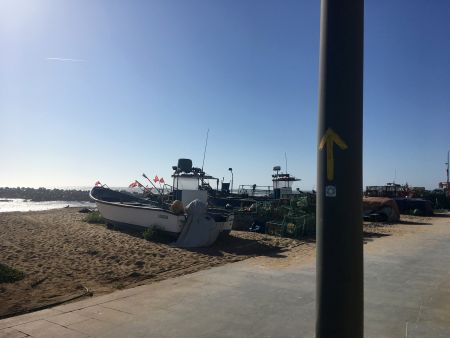
The whole way to Santiago, you follow yellow arrows that show
the way. Blue arrows point back to Fatima.
|
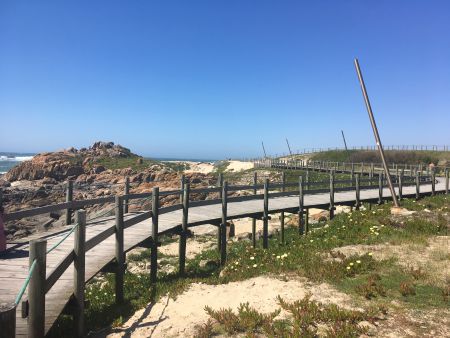
I was truly surprised by the variety of walking on the
Portuguese Way. You walk through small villages, through woods
and fields, on boardwalks, on sand, through mud, through
cities. It's often quite empty, so you can choose to walk in
solitude or with others.
|
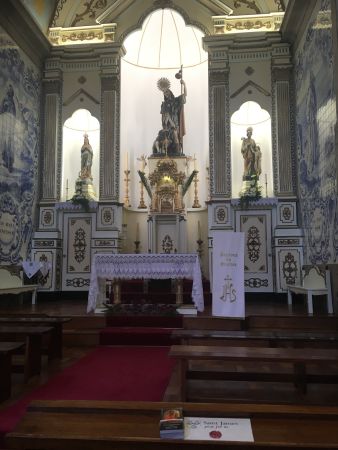
A charming little church north of Vila do Conde dedicated to
Santiago (St. James) and St. Roque (a patron of pilgrims and a
saint who would show up several times to assist during the
pilgrimage). St. Roque is the central statue, with a dog,
wounded leg, and pilgrim gear.
|
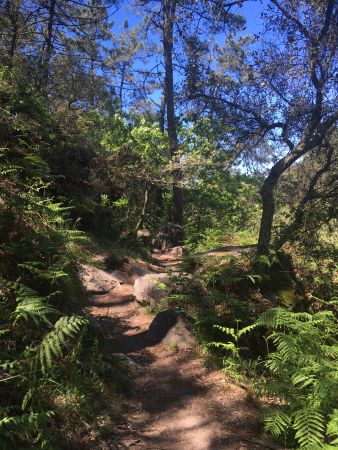
The third day brought lots of hills and required hiking small
paths filled with boulders. It was hot, and the sounds of
rushing water down in the valley were mesmerizing.
|
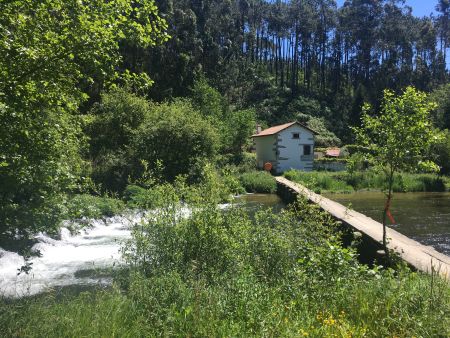
Below, a stone bridge carried me over the little Nieve River.
|
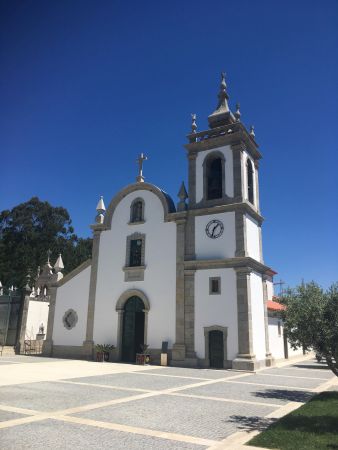
The same day I was hiking up and down the hills, I was looking
forward to visiting an important church regarding the history
of the Camino Portuguese. It was just after the Neiva River
crossing, and is called Santiago de Castelo do Neiva. Looking
at my map, it looked like an easy 2 km. In reality, it was all
uphill.
|

Inside the church, behind this altar devoted to Our Lady of
Sorrows and the souls in purgatory, you can see a brown
rectangle with an incription. This is a consecration of the
church to St. James from the year 862, the oldest dedication
of a church to St. James the Greater outside of Spain. This
shows that devotion to him (and pilgrimages) started early in
Portugal. (intentions on the altar)
|

Outside, I turned and saw that the climb was worth it. The
church is on the far left, the Atlantic on the far right in
the distance.
|
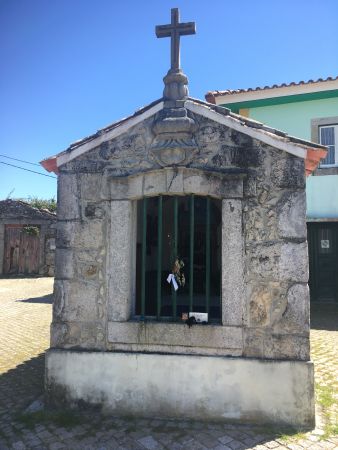
Portugal is full of little chapels. This one, devoted to Our
Lady, is in the middle of a village road where I went off the
path and got a bit turned around while searching for another
church (in reality, you never get lost on the Camino - you are
led to see or experience something you wouldn't find on your
own.) (intentions in the window)
|

The immediate area of the chapel is gorgeous and peaceful -
little tables, flowers, and the famous blue tiles of Portugal.
|
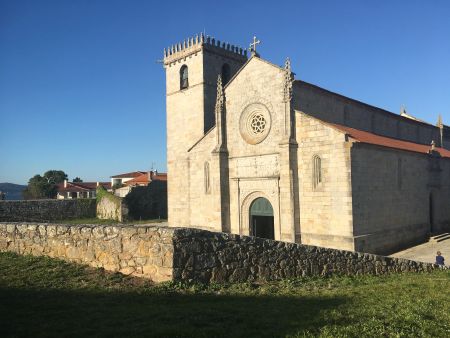
I went to Sunday Mass in this remarkable church in Caminha
(Igreja Matriz). It's on a raised area of town where you can
look across the Minho River into Spain, and must have
witnessed some awful things in the many years when Portugal
and Spain were bitter enemies.
|

Inside is a stupendous gold chapel dedicated to Jesus the Man
of Sorrows. Two ships hang from the ceiling, as it is also a
chapel for the protection of all who sailed from this part of
Portugal.
If you open the photo link and look closely at Jesus, you will
see that it depicts him as the mocked king, when he was
crowned with thorns and clothed in a scarlet robe. The
soldiers then mocked him, saying, "Hail, king of the Jews!"
The iconography of this chapel reveals the truth - the gold
and splendor surrounding the mocked, beaten Christ is fit for
a true king, which Jesus is - he is King of all Kings. The
soldiers unwittingly proclaimed the truth when they mocked
him, and this chapel shows the dichotomy with rare skill.
(intentions on the prayer kneeler)
|
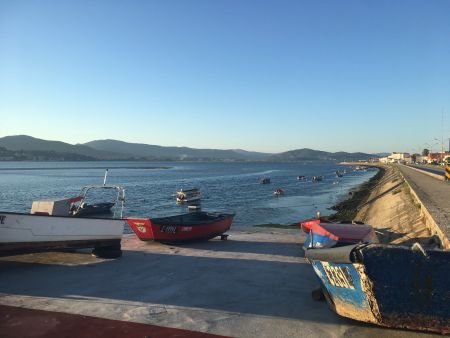
Boats on the Minho River. The Minho is the northern border
between Spain and Portugal.
|
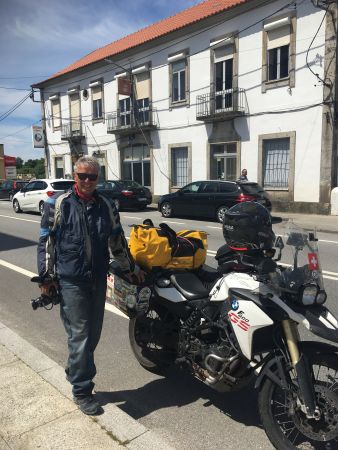
This man was returning home to Switzerland from a 100,000 km
around-the-world motorcycle trip. He was on his sixth set of
tires and third chain, but had no mechanical issues with the
BMW.
|
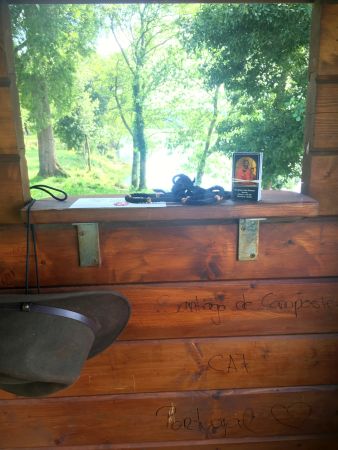
The day after arriving in Caminha, I walked along the River
Minho to join up with the main Portuguese route to Santiago. I
saw no other pilgrims all day, and the shopkeepers and
restaurant staff I interacted with were a bit cold, which is
shocking in such a friendly and outgoing country as Portugal.
I was beginning to feel low even though the scenery and
walking conditions were great.
I passed through a park that had a little wood shelter by the
river, and I felt moved to go inside and reapply some
sunscreen. On the wall, someone had written "Santiago de
Compostela.......CAT..........Portugal" with a heart. I
suddenly felt uplifted, and continued on with a lighter heart.
|

A typical sight along the Portuguese Camino - I can't
recommend this route enough.
|

Portugal was wonderful, but Santiago awaits us in Spain! Part
of the bittersweet nature of pilgrimage (and life) is that we
can't see and do everything that attracts us. In addition, we
must continue past and leave behind the delights we find on
the way. We enjoy them while we can, but we can't get to our
goal unless we keep moving. It is a constant lesson in
detachment.
|
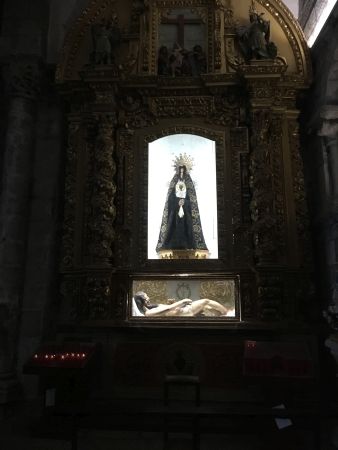
Tui is just over the border into Spain, and this chapel is in
the Tui Cathedral. The people of the Iberian Peninsula are
masters of the art of dramatic chapels.
|
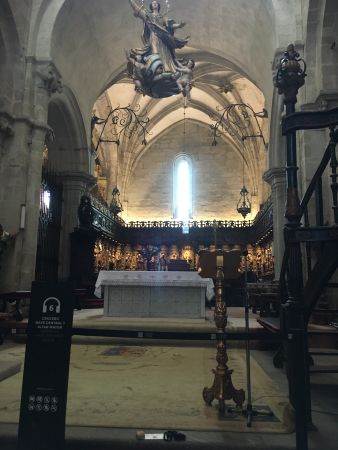
The main altar of Tui Cathedral. (intentions at the bottom
right)
|
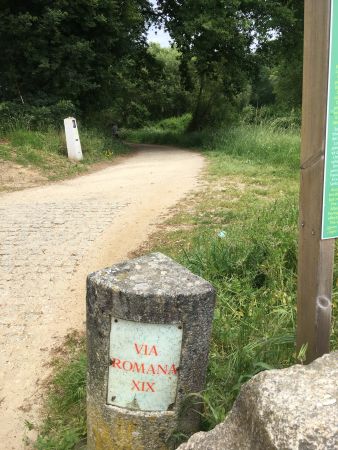
Many sections of the Camino followed the old Roman XIX road
that was built when the Roman Empire needed "interstates" on
which to move armies and goods. The medieval pilgrims would
have followed the same roads to Santiago. Unfortunately, the
Romans liked to build their roads straight over hills instead
of using switchbacks, so you gets lots of climbing time on the
Camino.
|
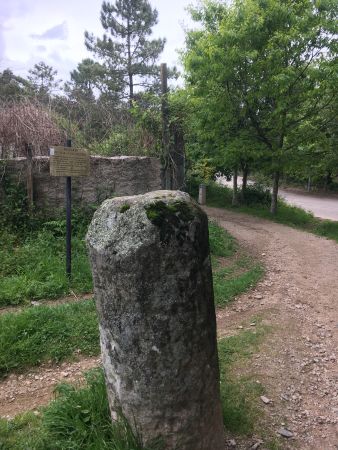
A Roman mile marker on the XIX.
|
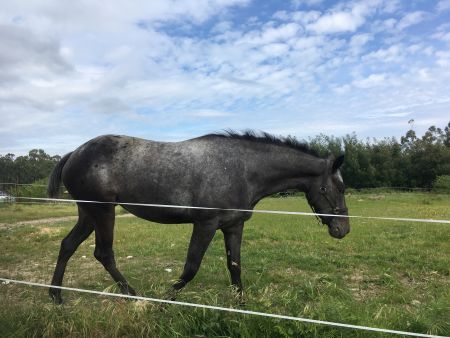
|
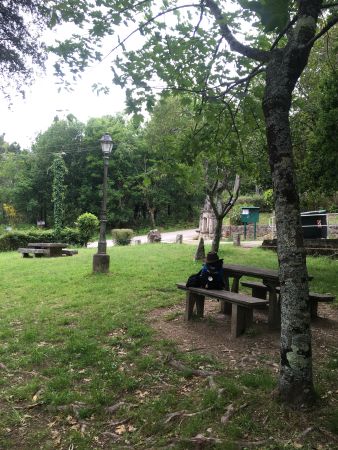
At the of yet another steep climb up a hill, I found this
oasis. There is a fountain in the background.
|
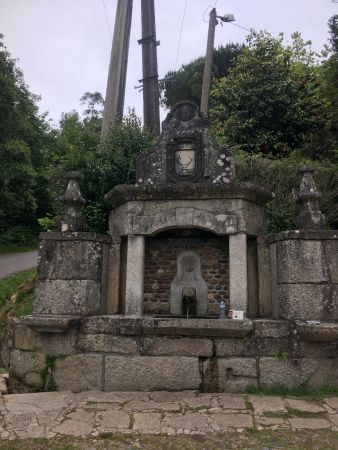
The fountain was a glad sight, for I was very thirsty. After
drinking, I looked up and saw the carving of the chalice and
host above the spigot. The carving brought to mind an allegory
of how the fountain and the little oasis where I was able to
rest were an image of Heaven. Revelation 22 speaks of how the
water of life flows from the throne of God, and all who are
thirsty can come and drink freely. The Eucharist is God in all
His Glory, and here is a fountain where you can drink your
fill.
|

A little church dedicated to St. Martha. It was a little haven
that was quiet and restful.
|
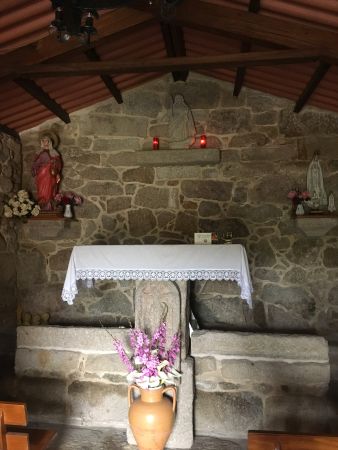
Inside St. Martha's church
(intentions on the altar)
|
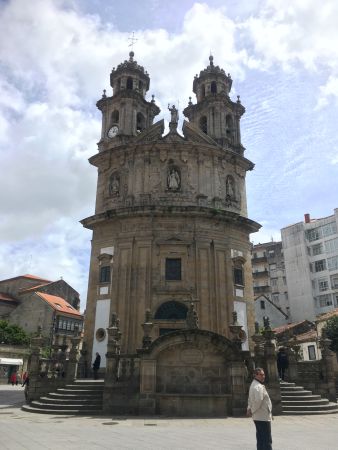
The round church La Peregrina in the city of Pontevedra. It is
dedicated to Our Lady in the guise of a pilgrim ("peregrina"),
as she is the patroness of the Portuguese Camino. The floor
plan is in the form of a scallop shell.
|

The altar of La Peregrina, with your intentions off to the
side. If you open the larger photo, you can see the Holy
Family on the road as pilgrims. The statue of Our Lady and
Jesus shows her with the scallop shell on her hat, staff with
attached water gourd, and cloak. These signify her and Jesus
as pilgrims to Santiago.
|

A bench inside La Peregrina along with all my worldly
possessions this side of the globe.
|
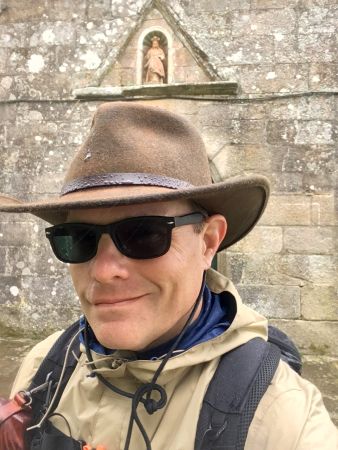
And then came the rain. This photo was taken in front of a
little church devoted to St. Marina, a young woman who was
martyred in the second century. Though the church was locked,
I was able to take refuge under a roofed portico on the side
of the church and pray the Office for the day while I rested
my feet and got my rain gear on.
|

The pouring rain made photos difficult, but I soon made it to
Padrón's Igrexa de Santiago. This church houses the stone
pillar that, according to legend, the boat carrying St.
James's body was moored to. The pillar, called O Pedrón, gave
the town its name. You can see the top of the stone under the
inscription behind the altar.
|

The daily chore of stringing a line and hand washing clothes
is complete for another evening.
|
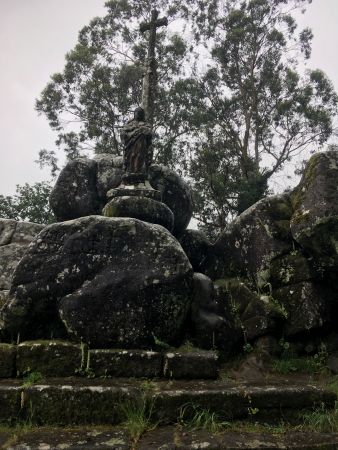
This site was perhaps the most moving place that I visited the
entire trip. Called Monte Santiaguiño, it marks the location
where St. James first preached on the Iberian Peninsula, and
later sought refuge when his life was threatened
To reach it, you must climb a steep series of steps behind the
church where the pillar is located .That day it was raining
intermittently, and sheets of mist and fog moved through the
landscape. There was nobody else in the area for the entire
time I was there, so it was a special visit. As soon as I
started walking down, 2 pilgrims arrived, so St. James has
great timing. Your intentions are at the feet of the statue of
St. James.
|

Lots of rain meant lots of
mud.
|
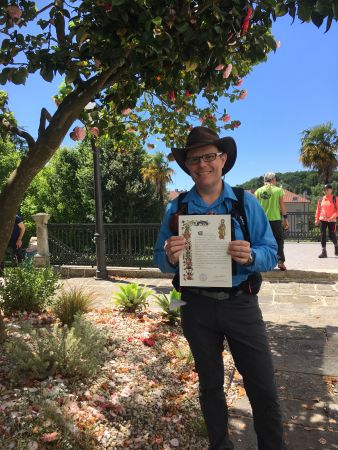
One credencial earned! The credencial is the certificate given
to pilgrims who complete the Camino with a religious
motivation.
|
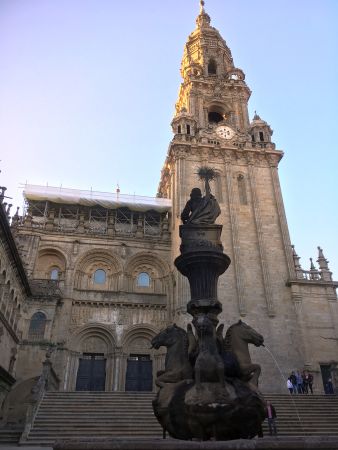
Traditionally,
Portuguese arrivals to Santiago entered the church at the
southern side, called the façade das Pratarías ("facade of the
Silverware"), named because of the large group of silversmiths
that were found in the area. Its facade dates from the early
1100s. The statue above the horse fountain is an angel who is
seated upon the sarcophagus of St. James.
|
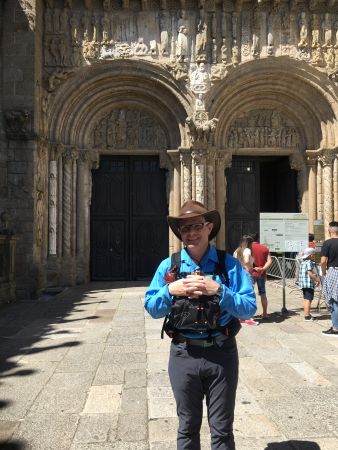
In front of the façade das Pratarías. Because of massive
renovations going on inside the church, this is the only
entrance. Most of the interior of the church is closed off or
shrouded, so there weren't many good photos to be had. The
goal is to have it completed by 2021, so plan your trip after
that!
|

I brought your intentions to the sepulcher containing the
reliquary that holds the remains of St. James and his two
disciples, Athanasius and Theodore.
|
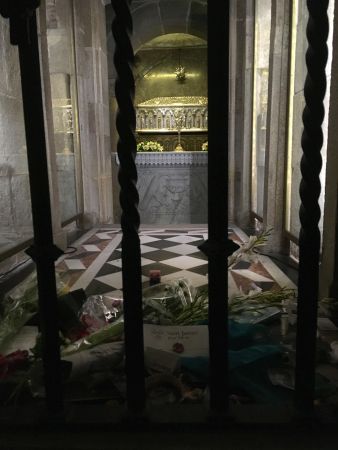
I then placed them beyond the gate. It felt strange leaving
them after carrying them so far and being so careful not to
forget them!
|
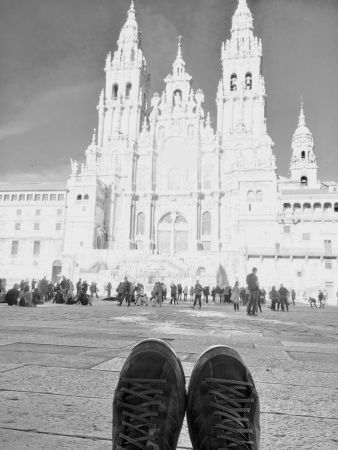
Mission complete.
|
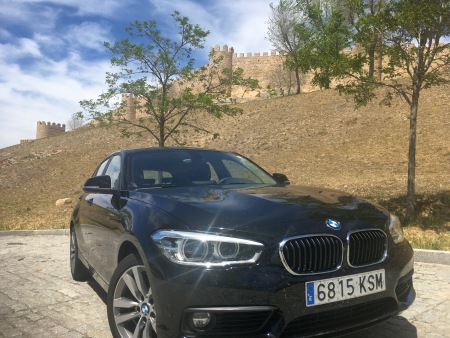
I rented a car to drive from Santiago de Compostela to Madrid,
and paid for a tiny Fiat, as driving in Europe is far easier
with a small car. The company upgraded me for free to a BMW,
but it ended up having a leaky tire I kept having to stop and
refill, and it was a pig to park. One thing it had going for
it was it looked cool outside of the walls of Avila.
|
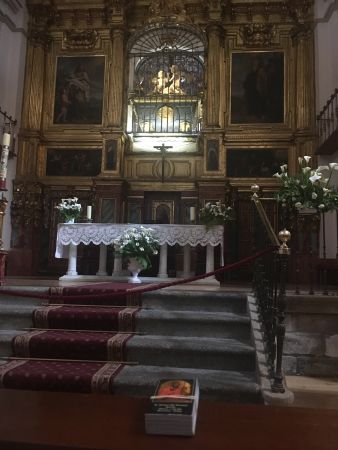
On the way back to Madrid, I stopped to visit a few
friends/mentors. First up was St. Teresa of Avila's tomb in
Alba de Tormes near Salamanca.
|
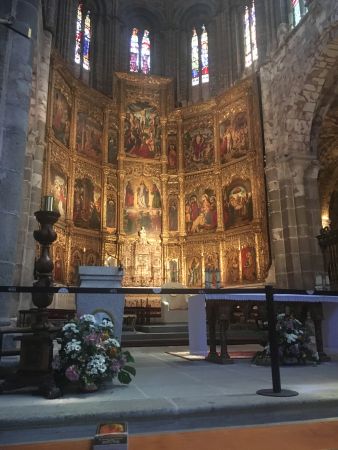
Avila Cathedral
|
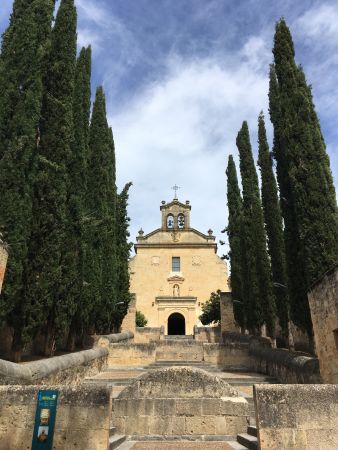
Finally, a quick drive to Segovia near Madrid to see St. John
of the Cross. This is the monastery church where St. John of
the Cross is buried. I did briefly spot the famous Roman
aqueduct in Segovia while I was stuck in traffic and puzzling
out my GPS.
|
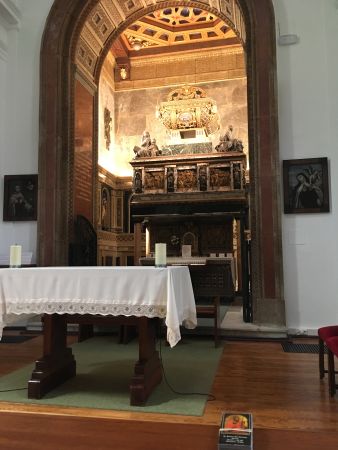
Tomb of St. John of the
Cross in Segovia
|
